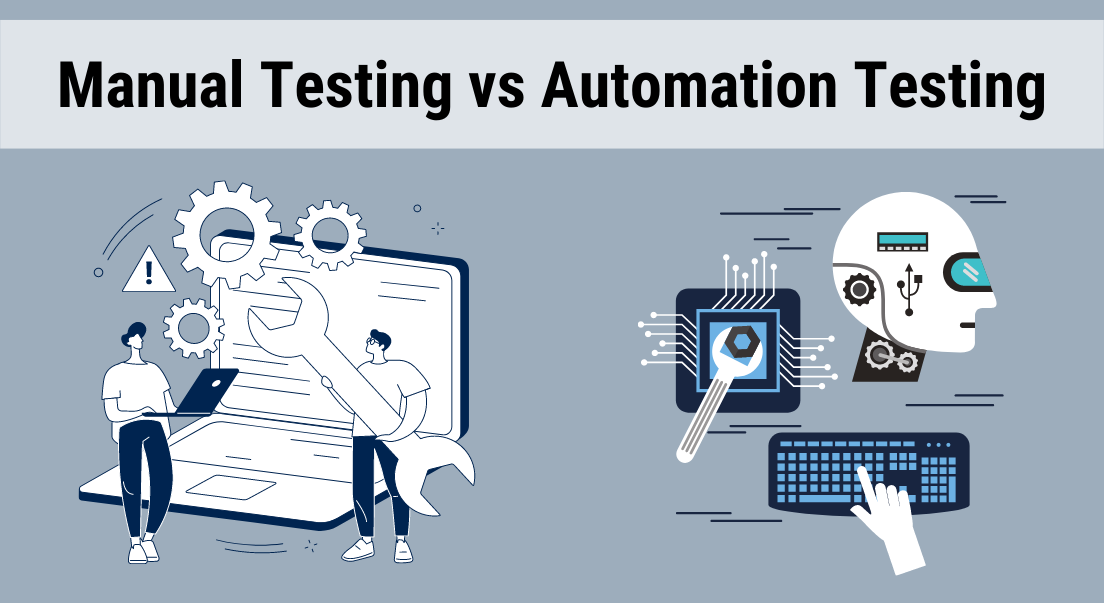Manual Testing vs Automation Testing
In recent years, the use of methodologies like Agile and DevOps in software development has been rising with more and more companies adopting these approaches. The increasing use of those approaches, leaving the traditional methodologies such as waterfall behind, caused many changes in the software development life cycle mainly to deliver faster than before. Software testing is a crucial part of the development process, and therefore making this process more agile and effective is a high-value target for companies.
To achieve this desired target, many organizations are using automation testing whenever possible instead of traditional manual testing. While each technique has its advantages and disadvantages, there are also meaningful differences that you must be aware of to fully understand those two techniques. In this article, we will provide you with all the basic information, main differences, and pros and cons of manual testing vs automation testing.

What is Manual Testing?
Manual testing means that a human controls and executes the entire test from end to end. Since in manual testing the testers carry the whole responsibility of the test, there is a greater importance to their experience and skills. The chance to have a human error in this type of testing is high and the process can be long and time-consuming.
Manual testing doesn’t require specific programming language knowledge from the human workforce, which is the primary allocated resource. In this testing, the tester's sight is an advantage and could play a crucial role in finding visual bugs in the software. In addition, if the testers unexpectedly find a certain problem during some test they have the flexibility and freedom to test it even if it wasn’t the original intention of the test. Some tests can be executed only manually like exploratory tests.
Advantages of Manual Testing
- Doesn’t require programming knowledge
- Efficient in finding visual bugs
- More flexibility and freedom for the tester
What is Automation Testing?
Automation testing is when a certain test is executed by an automation tool without the intervention of a human worker. To run an automation test, the tester needs to be familiar with some programming languages to create test scripts for the tool to follow in the test. When the test is finished, the actual results are compared with the anticipated results, which gives the tester an understanding if the test passed or failed. Automation testing is considered very reliable and effective due to the fact there is no possibility of human error.
Using automation testing is a significant time-saver and allows us to complete tests much more quickly than manual testing, eventually it contributes to achieving better ROI. Moreover, automation testing also provides better testing coverage ensuring that the whole software testing process is complete. In automation, test scripts used on a certain test can be reused again whenever needed and make the process easier. Some test types execute particularly as automated tests, for example, load testing or stress testing.
Advantages of Automation Testing
- Reliable, effective with minimum risk
- Fast and time-saving
- Provides better test coverage
- Test scripts can be reused when needed
Comparison between Manual Testing and Automation Testing
| Manual Testing | Automation Testing | |
|---|---|---|
| Definition | A human is controlling and executing the entire test from end to end | Automation testing is when a certain test is executed by an automation tool from A to Z |
| Reliability | Less reliable, a higher chance of human error | More reliable, less chance of mistakes |
| Time-frame | Slower and more time consuming | Faster and less time consuming |
| Allocated resources | Less expensive, only human workforce | More expensive, automation tools and human workforce |
| Relevant tests | Exploratory test, usability test | Regression testing, load testing |
| Advantages |
|
|
Summary
In brief, the software development process these days is about releasing better and faster. Towards achieving these goals and making the process as agile as it can be, many organizations use automated testing wherever possible. Automation testing is done entirely by automation tools and does not require human intervention during the testing process. Automation testing helps to shorten the time frame of tests, ensure better test coverage, and more efficient and reliable testing. Manual testing, on the contrary, is executed only by a human tester that is responsible for the whole testing process from A to Z.
Whether you are using manual testing or automation testing, test management platforms such as PractiTest could significantly help you monitor and control your entire testing efforts. With PractiTest, you ensure the whole software testing process is covered, gain visibility via personally customized dashboards, and eventually deliver faster.











